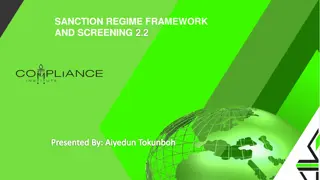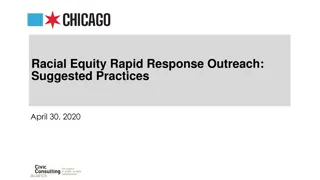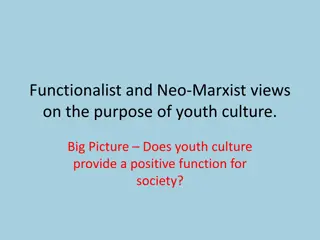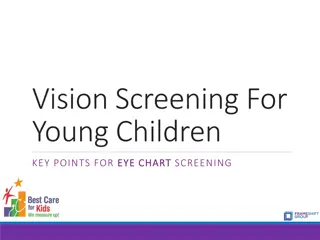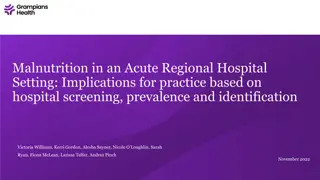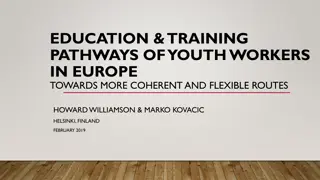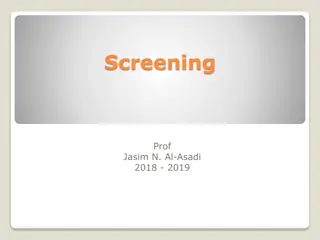Understanding Screening and Assessment in Youth Work
This comprehensive guide explores the essence of screening and assessment in working with youth. It covers the methodology, learning objectives, best ethical practices, legal and ethical concerns, and the distinction between screening and assessment. The content emphasizes the importance of ethical guidelines, trauma-informed skills, and effective management of crises when working with young individuals. It also delves into how to conduct screenings and assessments of youth actively using, incorporating case management principles.
Download Presentation

Please find below an Image/Link to download the presentation.
The content on the website is provided AS IS for your information and personal use only. It may not be sold, licensed, or shared on other websites without obtaining consent from the author. Download presentation by click this link. If you encounter any issues during the download, it is possible that the publisher has removed the file from their server.
E N D
Presentation Transcript
Methodology: Required Materials: Duration: 6 hours Active discussion Case Study Role Play Easel Pad Participant Manual Notepad for each participant Pens & Pencils SCREENING & ASSESSMENT
SCREEENING & ASSESSMENT Learning Objectives To learn the difference between screenings and assessments. To understand ethical guidelines when working with youth. To incorporate trauma-informed skills when working with youth.
SCREENING & ASSESSMENT Learning Objectives continued To understand the goals of screenings. To effectively manage crises To conduct effective screenings youth.
SCREENING & ASSESSMENT Learning Objectives continued To understand de goals of assessments. To learn about assessment methods and tools To conduct effective assessments of youth who are actively using. To learn the importance of case management.
SCREENING VS. ASSESSMENT Screening is a process for evaluating the possible presence of a particular problem. The outcome is normally a simple yes or no. Assessment is a process for defining the nature of that problem, determining a diagnosis, and developing specific treatment recommendations for addressing the problem or diagnosis. (SAMHSA/CSAT, 2009)
BEST ETHICAL PRACTICES WHEN WORKING WITH YOUTH Justice Beneficence Respect for People s Rights and Dignity Fidelity & Responsibility Autonomy Integrity (ACA, 2014; APA, 2017)
LEGAL AND ETHICAL CONCERNS Some important concerns to take account are: o Confidentiality restrictions o When may confidential information be shared with others. o Rules about obtaining adolescent consent to disclose treatment information oThe signature of the adolescent (and the issue of parental consent) (Treatment Improvement Protocol, 1999)
TRAUMA INFORMED INTERVIEWING Create a Safe Environment: Use universal precautions of care. Trauma informed care starts at first contact with youth. Comfort Statements. Buildings relationships and connectedness: Informed consent and full disclosure. Supporting and teaching emotional regulation: Constant assessment of potential discomfort. Manage crises
THE ROLE OF THE INTERVIEWER / PROVIDER (SAMHSA, 2015)
MANAGING CRISES DURING SCREENINGS & ASSESSMENTS Trauma disclosures. Suicidal thoughts or feelings. Violence.
TRAUMA DISCLOSURES Redirect and stop. Attend to the client s feelings. Stabilize Check legalities (SAMHSA, 2015)
SUICIDAL THOUGHTS OR FEELINGS Understanding suicide GATE is an intervention for suicidal thoughts or feelings Gather information Access supervision Take responsible action Extend the action (CSAT/TIP, 2009)
VIOLENT BEHAVIOR Understanding the type of aggressive behavior. Physical safety Verbal Strategies (CPI, 2020; CWTI, 2006)
SCREENING Should last no more than 30 minutes Simple instrument Relationship to substance Frequency Severity Should take place in private area. (SAMHSA/CSAT, 2009)
SCREENING METHODS Brief structured interview questions Youth participation Caregiver/Parent Screening Tools NIDA -12 questions CRAFFT 6 questions
National Institute on Drug Abuse (NIDA) Screen NIDA Screen is a set of brief questions on the use of substances. Has a suggested script to help youth understand the nature of the questions.
Lets Practice!
CRAFFT Screening Tool 6 questions. Each questions equal to one point. 20 languages. (CRAFFT.ORG, 2020)
Lets Practice!
ASSESSMENTS What is an assessment? An assessment is a process that consists of collecting data, interpreting it and developing a plan based on the strengths and weaknesses that are revealed through the data. The patient assessment includes capacities, strengths, problems, needs and resources, as well as weaknesses and risk areas. To sum up, the assessment includes all the positive and negative aspects of the patient.
ASSESSMENTS What is the Relationship between the Assessment and Treatment Planning for Drug and Alcohol Use? 1.It s the first step in formulating a treatment plan. 2.It s a continual process, which starts with an early assessment and continues throughout the whole treatment process
ASSESSMENTS Comprehensive Assessment Physical Health Psychological Health Social Assessment Vocational/Educational Assessment
ASSESSMENTS Global Appraisal of Individual Needs (GAIN) Teen Addiction Severity Index (T-ASI)
Global Appraisal of Individual Needs (GAIN) Semi-structured interview 75 100 minutes to administer, 15 to score (GAINCC.ORG, 2015)
Teen Addiction Severity Index (T-ASI) Semi-structured interview 30 45 minutes to administer, 10 to score (Kaminer et, al 2009)
HEADSS Interview 3 90 minutes (Cohen et al, 1991)
Lets Practice!
OTHER SCREENIGNS & ASSESSMENTS Adolescent Health Review (AHR) Adolescent Substance Abuse Subtle Screening Inventory (SASSIA2) Brief Psychiatric Rating Scale Children (BPRS-C)
CASE MANAGEMENT Case Management Case Coordination Casework (CMSA.ORG, 2017)
TRUST AND RELATIONSHIPS PROVISION OF RESOURCES PROVISION OF SERVICES GENERAL CASE MANAGEMENT FOLLOW UP CONSTANT ADAPTATION TO MEET CLIENT S NEEDS
WRAP AROUND MODEL Evidence-based case management method. Principles: Voice & Choice at the core Individualized care Strengths-based Natural Supports Team-based collaborative planning Unconditional Care Community-based care Culturally Competent Outcome-based (Burns, 2008; NWI, 2008)
The Strengths & Needs Assessment (SNA) Tool (Lyons, 2016)
Assessment of Survivor Outcomes (ASO) (IJM.ORG, 2018)
Lets Practice!
CLINICAL CASE STUDY Lidia is 15-years-old, Hispanic, heterosexual adolescent. Lidia is an immigrant, she arrived at the country when she was 8 years old but is currently undocumented in the current country. Lidia was hospitalized due to suicidal ideations. You re the case manager who is meeting with her prior to her discharge. During your assessment you find out Lidia s history of sexual trauma by her uncle, from the age of 9 through 12. Lidia verbalizes previous suicidal attempts and recent cutting. Although Lidia speaks the main language, she struggles academically, and in the past, she has skipped school various times. You also find out that Lidia will be living with her mother, who does not believe the abuse happened. Lidia believes her family does not like her because she told about the abuse by her uncle who is in jail, she mentions that her aunt told her you broke the family apart . Lidia admits to trying several drugs throughout the last few years. She admits to heavy use of alcohol, some marihuana and trying mushrooms one time. Her drug of choice is alcohol and she is not willing to stop the use. Lidia also admits to having unprotected sex with several peers when drunk in the past.








